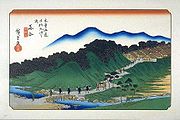
Ochiai-juku
Encyclopedia

69 Stations of the Nakasendo
The are the rest areas along the Nakasendō, which ran from Nihonbashi in Edo to Sanjō Ōhashi in Kyoto. The route stretched approximately and was an alternate trade route to the Tōkaidō.-Stations of the Nakasendō:...
of the Nakasendō
Nakasendo
The , also called the , was one of the five routes of the Edo period, and one of the two that connected Edo to Kyoto in Japan. There were 69 stations between Edo and Kyoto, crossing through Musashi, Kōzuke, Shinano, Mino and Ōmi provinces...
. It is located in the present-day city of Nakatsugawa
Nakatsugawa, Gifu
is a city located in the Tōnō region of Gifu Prefecture, Japan. The city was founded on April 1, 1952.-History:During Japan's Edo period, Nakatsugawa was a post town, known as Nakatsugawa-juku, one of the 69 Stations of the Nakasendō along the Nakasendō. The travel route ran from the Nihonbashi in...
, Gifu Prefecture
Gifu Prefecture
is a prefecture located in the Chūbu region of central Japan. Its capital is the city of Gifu.Located in the center of Japan, it has long played an important part as the crossroads of Japan, connecting the east to the west through such routes as the Nakasendō...
, Japan
Japan
Japan is an island nation in East Asia. Located in the Pacific Ocean, it lies to the east of the Sea of Japan, China, North Korea, South Korea and Russia, stretching from the Sea of Okhotsk in the north to the East China Sea and Taiwan in the south...
. The honjin
Honjin
thumb|250px|The honjin at [[Inaba Kaidō]]'s [[Ōhara-shuku]]. is the Japanese word for an inn for government officials, generally located in post stations during the later part of the Edo period.-Evolution of Honjin:...
and the sub-honjin, as well as some old street lights, remain from the Edo period
Edo period
The , or , is a division of Japanese history which was ruled by the shoguns of the Tokugawa family, running from 1603 to 1868. The political entity of this period was the Tokugawa shogunate....
. The Honjin were the main rest areas in old post towns and very few remain today. There are ten hills that must be traversed to get to Ochiai-juku from the preceding post town of Magome-juku.

